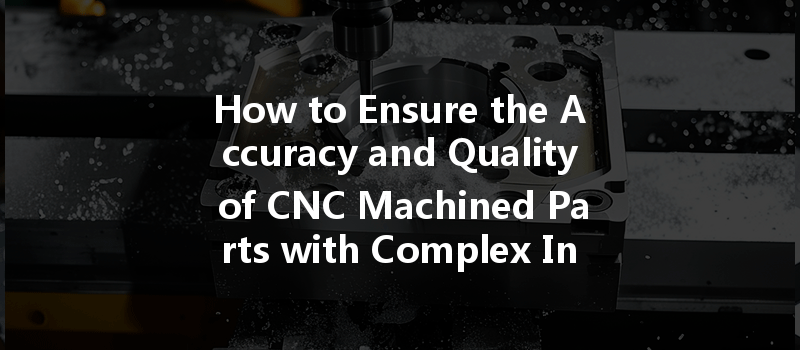: The Challenge of Complexity
Did you know that nearly 70% of engineering failures can be traced back to poor component quality? In the world of precision engineering, unless you’re creating simple geometric shapes, achieving accuracy in CNC machining—especially for parts with complex inner cavity structures—poses a unique set of challenges. As industries strive for ever-greater precision, ensuring the accuracy and quality of machined components remains paramount. Complex structures often hide problems that are invisible until it’s too late, which can lead to costly reworks or even complete project failures.
In this blog, we’ll delve deep into the strategies and technologies that can help you ensure the highest accuracy and quality of CNC machined parts featuring intricate designs. Whether you’re involved in aerospace, automotive, or medical device manufacturing, understanding these techniques will elevate your production capabilities.
Understanding the Complexity of CNC Machining
To appreciate the challenges of machining complex inner cavities, you must first grasp what CNC (Computer Numerical Control) machining entails. CNC machining uses computer-aided design (CAD) files to guide the manufacturing process, mechanizing everything from drilling to milling. The versatility of CNC machining makes it ideal for creating precise parts, but complexities arise when dealing with intricate designs.
Many components, especially those used in advanced applications, feature inner cavities that are not only complicated to program but also challenging to measure. Heightening the task at hand is the fact that parts must often meet stringent tolerances and surface finish requirements.
Key Factors Influencing Accuracy in Machining
Choosing the right material is crucial. The characteristics of different materials affect their machinability and the resultant accuracy. For example, softer materials may yield better tolerances and surface finishes while harder materials may require special tooling and techniques to maintain precision. Understanding the mechanical properties of materials—such as hardness, thermal stability, and tension—is critical for successful machining.
The tools you opt for can significantly impact the overall quality and accuracy of your CNC machining operations. Selecting the right cutting tools, including the type, size, and geometry, can provide more control when machining complex inner cavities. It’s essential to choose tools that are tailored to the specific material and the complexity of the design.
A calibrated CNC machine is non-negotiable. Consistently maintaining your machine’s calibration ensures that the dimensions produced will meet design specifications, particularly in intricate shapes. Regular calibration checks and maintenance should be part of your machining protocol.
The precision of CNC machined parts heavily depends on the programming. Employing advanced programming techniques, like simulation before actual machining, can help uncover potential issues. Using algorithms to define tool paths that minimize unnecessary movements can enhance execution speed without sacrificing accuracy.
Proper coolant and lubrication are essential in CNC machining, especially when working with complex inner cavities that can create heat accumulation. Flame-hardened tools or plastic-components often require specialized cooling methods to ensure the machining maintains consistent temperatures, which ultimately affects the quality and longevity of the tool.

Strategies for Achieving Accuracy in Complex Inner Cavities
Multi-axis CNC machines offer a way to achieve intricate designs with greater accuracy. Unlike traditional 3-axis machines, multi-axis tools can move in additional dimensions, allowing for complex inner contours to be created without re-fixturing parts. This reduces chances of inaccuracies arising from misalignment.
One way to ensure accuracy is to incorporate laser scanning into your inspection processes. Laser technology can quickly generate 3D models of parts during production, which can then be compared with the original CAD files. This real-time feedback loop allows for adjustments to be made during the machining process.
For particularly complex designs, utilizing additive manufacturing (3D printing) in conjunction with CNC machining can enhance the production process. By creating rough prototypes with 3D printing, you can identify design flaws early on without committing to costly materials.
The design of fixtures plays a crucial role in producing accurate parts. Securely holding the workpiece in place with minimal vibration or movement is essential. Advanced fixturing systems can adapt to provide support across multiple axes, ensuring that even the most complex inner cavities are accurately machined.
Embrace data analytics to track machining performance metrics. By collecting data on tool wear, temperatures, and machining time, engineers can optimize the machining process. Real-time data can lead to proactive maintenance, minimizing downtime and enabling continuous improvement of quality.
Closing Thoughts: The Importance of Precision in CNC Machining
Navigating the complexities of CNC machining—especially for parts with intricate inner cavity structures—is an evolving challenge that can’t be ignored. By implementing the strategies discussed above, manufacturers can ensure that their processes are aligned to achieve the highest accuracy and quality standards.
Investing in the right technology, tools, and processes isn’t just about meeting design specifications; it’s about safeguarding the longevity and functionality of your products in a competitive market. As we advance further into a more technologically driven era, understanding and leveraging these factors will remain crucial.
Ultimately, the ability to produce parts with high precision and quality is a reflection of a company’s competence and dedication to engineering excellence. As you contemplate these strategies, consider how they can be tailored to your specific needs—because, in the world of CNC machining, accuracy isn’t just an advantage; it’s a necessity.
This blog is not just an informational piece; it’s a conversation starter about continuous improvement in manufacturing processes. Your thoughts and implementations could lead to breakthroughs in efficiency and quality that set new industry standards. Let’s engage in this dialogue to elevate the future of precision engineering.
Related Posts
- How does a CNC aluminum machining plant handle the ultra-precision machining needs of aluminum parts?
- What are the advantages of CNC machining with 5-axis capabilities for rapid production of complex parts?
- How Can You Improve Machining Accuracy for Difficult-to-Machine Materials in Five-Axis Machining?






